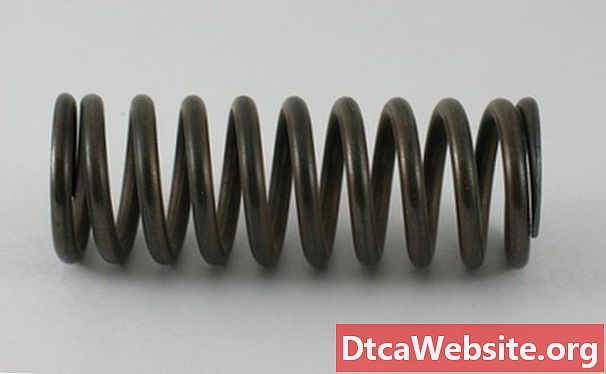
Contenu

Gas springs provide a constant linear force over a defined stroke, as well as dynamic damping from their integral piston to smooth their action. The extremely high pressure of the nitrogen gas inside is only applied to the net cross-sectional area of their piston rod and not the entire piston, keeping volumetric changes inside the cylinder small and pressure and resultant forces near constant. This quality makes gas springs infinitely useful for providing opening and closing forces for doors and hatches, as well as moving mechanisms on machines.
Step 1

Define the gas spring placement or installation application. In this case, a set of two gas springs will be used to hold open an 8-foot-long, 6-foot-wide hinged hatch cover on a fishing boat. The cover weighs an evenly distributed 80 pounds. Two gas springs are available for the application, but no information has been provided about where the springs should be located except that the hatch cover should be held open at a 45-degree angle when lifted. With specific information about the springs, you can calculate their correct placement.
Step 2

Determine the characteristics of the two available gas springs. Each spring has a constant extension force of 100 pounds, and is 24 inches long when extended, and 16 inches long when fully compressed. Stroke is the extended dimension less the compressed dimension, or 24 inches - 16 inches = 8 inches.
Step 3

Determine the general formula governing gas spring applications and carefully note the accompanying diagram that explains the geometry of a gas spring application. The formula according to one major manufacturer to determine extension force is F1 = (Fg x Lg/n x L1) x R, where F1 equals the extension force of the spring; Fg equals the vertical component of gravity pulling the load (hatch cover) down (when it is open 45 degrees in this example); Lg equals the horizontal distance from the pivot (hinge) to the center of gravity (center of hatch); n equals the number of gas springs available to bear the load; and L1 is the perpendicular distance between the pivot of the cover and the bottom pivot of the gas spring. R is a force safety factor of 1.2, so that the spring has at least 1.2 times the force it needs to hold the cover open.
Step 4

Rearrange the required force formula to solve for L1 and Lg, which are the two dimensions that will determine spring placement. Therefore, L1 = Lg x R x Fg/(F1 x n). Since the Lg of the 8-foot cover is the sine function of 45-degrees x 8 feet/2 (center of gravity when the cover is open), Lg = 2.83 feet.
Step 5
Solve for L1 by substituting real values in the rearranged equation. L1 = 2.83 feet x 1.2 factor x 40 pounds/(100 pounds spring force x 2 springs) = 0.6792 feet x 12 inches/foot = 8.15 inches. Therefore, mount the gas spring base end (piston rod end down) 8.15 inches from the hinge pivot pin on the side flange or opening to the hatch.
Add the 16-inch retracted length to the 8.15 inches to properly locate the upper end of the gas spring at least 24.15 inches from the hinge pivot. Increasing this latter distance increases the force to hold the cover open.
Tips
- The safety factor to the cover can be increased to compensate for snow or other loads by moving the base pivot or top pivot farther away from the hinge.
- To hold the cover down when closed, the lower gas spring pivot must be slightly above the pivot on the hatch itself by installing a 2-inch perpendicular bracket on the hatch.
Warnings
- Gas spring application is a delicate science and every manufacturer recommends consulting its engineers before deciding on any application to prevent damage or injury.
- Gas springs are under extremely high pressure and should never be opened or handled roughly to avoid injury or death.
Items you will need
- Calculator
- Gas Spring Technology Compendium


